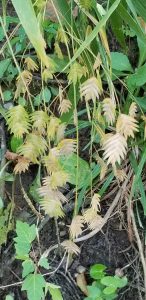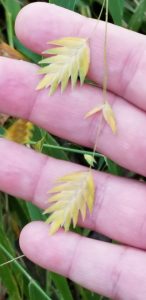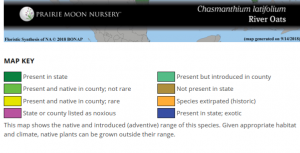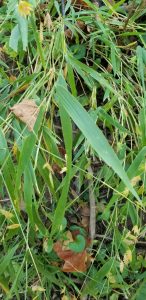I decided to go to my sit spot on a Sunday morning rather than a Monday morning because, well, I wanted to 🙂 I arrived at Brookside Park at 10:36 am on Sunday, October 4, 2020 and it was a chilly, yet beautiful morning. I sat down for a few moments, just to listen to the creek and gain my thoughts so that I could concentrate on my species that I was going to find and tackle today. I then walked along the creek bed looking at various new plants and flowers that had bloomed since the last time I was there. The bees were pollinating the little white flowers. I was going to choose those, but I figured that I would keep looking just to see what I could find. As a walked toward the NW of my sit spot location, to the right of me on the bank I found that looked to be a type of wheat. Completely confused as to why there would be wheat along a creek in Brookshide Park, I decided that this was what I was going to do my species summary on this week. Here are a few pictures of the beautiful wheat-like plant I found.
 I could not for the life of me figure out why this would be here, or how long it had been here, because I do not recall ever seeing it on my walks along there before. I was able to download an app on my phone called “Picture This.” It is a plant identification app that I was able to easily find this beautiful plant called and the following information about it:
I could not for the life of me figure out why this would be here, or how long it had been here, because I do not recall ever seeing it on my walks along there before. I was able to download an app on my phone called “Picture This.” It is a plant identification app that I was able to easily find this beautiful plant called and the following information about it:
Northern Sea Oat, which is a species of Chasmanthium. It is also known as the Indian woodoats, Inland sea oats, river oats, Spangle grass, and Broodleaf uniola.
This plant/grass is a summertime perennial that does will in partial to full shade. It can withstand temperatures as low as -30 degrees Fahrenheit and likes neutral soil that can either be slightly acidic or alkaline. It is also said to make a lovely addition to flower arrangements when it is dried. I personally think that it would look good in a fall arrangement myself!
 Why would this plant/grass be at my sit spot? Well, it turns out that this species form huge colonies on riverbanks to help protect the bank from “insidious erosion.” The Northern sea oat is native to the central and eastern United States; Manitoba, Canada; and Northeastern Mexico. It grows roughly three feet high and spreads 1-1.5 feet across and the flowers from 1-2 inches.
Why would this plant/grass be at my sit spot? Well, it turns out that this species form huge colonies on riverbanks to help protect the bank from “insidious erosion.” The Northern sea oat is native to the central and eastern United States; Manitoba, Canada; and Northeastern Mexico. It grows roughly three feet high and spreads 1-1.5 feet across and the flowers from 1-2 inches.
When I returned home, I started to look up more information on this plant and found a great deal of information. I first found www.mortonarb.org which gave me some more information about this plant. It prefers moist, well drained soil. It self-seeds and is know to have excessive plants because of this. The plant is known as a cultivar- a plant produced in cultivation by selective breeding or via vegetative propagation from wild plants that have identified to have desirable traits. There are no serious pest problems associated with the oats. The one thing that I questioned was that it was native to the Chicago area.
When I searched further, I was able to find a site www.loyno.edu (Loyola University New Orleans) and I found a treasure trove of information!
The Northern Sea Oat plant loves to be along the Gulf and Atlantic coasts and serves as a huge support for the beaches. This plant will stop sand from leaving the beach during a windy period. As the sand hits the plants, it will fall where it is and this is a way sand dunes are created! They are “tolerant of salt spray and rather high salt content in the soil around them” Research of these plants shows that the salt around the plants is a “principle source of nutrients” to it.
Their reproduction is interesting as they are both sexual and asexual. Mainly they are asexual, spreading via rhizomes. This is underground stems that occasionally sprout new plants. Sexually, they reproduce by windblown pollen fertilizing them or by floating on the surface of water. Here is a map of the regions where they are located.


This picture is from the site www.prairiemoon.com, a site where you can order plants, including the Northern Sea Oat. It is no wonder why Loyola University New Orleans has informed the public that this plant is protected by the government. Their value and their contribution to protecting and stabilizing the beaches. Cutting them down or digging them up can lead to fines or jail time.
By pulling up the website, you can zoom in on the picture and see that the states are broken up by county and you can see if this plant is native to your area! Well, for Roanoke, It is present, native, and not rare! I wonder if the obvious receding of the water from recent rain was able to wash some of the other natural debris away and let this shine through, because like I said, I hadn’t noticed it before!
It has been a lot of fun learning about the Northern Sea Oats! I thought I was going to pick something that was difficult to find, or that I would have to go through several apps and loops to figure it out, but it was super easy which made it a lot of fun to look further once I got home. It smells sweet and has long, bright green leaves. Not something that you would necessarily picture together. The oats on the end are working on preparing for winter, so they are turning brown since their blooming season is over. I thoroughly enjoyed this assignment and I look forward to seeing if it native where y’all live!

I loved how detailed you were. I agree with you in that the Northern Sea Oats would be very beautiful in a fall arrangement! I believe I have seen this organism in fields and parks before, and never gave it much thought. Now I know what to identify it as! Great job giving a large overview
I’ve always wonder how dunes are formed and now I know, so thank you for that. I don’t know very much about flower arrangements, so I’ll have to take your word for it. In your research did you find if they are harvested for food, edible, or is oat just a formality based on the plant itself?